Most people don’t think about their pelvic floor until something goes wrong with it. However, it’s very common for issues to occur in this part of your body— particularly if you are a women and especially as you get older.
The best case scenario is to start supporting your pelvic floor right now to avoid issues in the future. But the good news is that even if you are already dealing with a related problem, you aren’t at a dead-end.
There are numerous steps you can take from home to both strengthen and relax your pelvic floor (and all of them natural). First, though, it’s a good idea to learn more about this important body area that doesn’t get a lot of attention.
What is Your Pelvic Floor? + Key Functions
Your pelvic floor is a group of muscles and connective tissues that support key organs in your pelvis. These organs include many that you use everyday— bladder, bowel, urethra, uterus, vagina, etc.— so it’s not hard to see why a healthy pelvic floor is critical for your health in many ways.
Though most people don’t realize it, the pelvic floor is actually part of your core (the base of it, in fact).
Muscles in this area of your body allow you to expel urine and waste. Equally importantly, they help to keep urine from leaking out until you’re ready to pee. (At least, that’s how it’s supposed to work.)
Pelvic floor muscles also aid vaginal contractions and blood flow during sex (or erection/ejaculation for men) and are used for vaginal delivery during childbirth.
Common Pelvic Floor Issues

Issues with the pelvic floor can affect both men and women, though women are at a much higher risk. In fact, it’s estimated that about 1 in 3 women will deal with some kind of pelvic floor disorder (PFD) in their lifetime.
Pregnancy is one of the most commonly known “risk factors” for a PFD, since both vaginal births and Cesarean deliveries stress the pelvic floor. (Vaginal births are most likely to cause issues.)
But unfortunately, your risk of developing a PFD isn’t limited to pregnancy. Changing hormones during menopause and loss of muscle strength with age are also big contributing factors to pelvic floor issues. Overusing your muscles (as in heavy lifting, for example) and injury can lead to a problem as well.
If your pelvic floor muscles weaken, you might end up with:
- Bladder Control Problems (Incontinence)— Frequent urination, leakage (like when you laugh, cough, or sneeze), inability to “hold it in”.
- Fecal Incontinence— Struggle to control bowel movements.
- Pelvic Organ Prolapse— Organs like the bladder, uterus, and rectum drop due to lack of support. May cause a bulging vagina.
On the other hand, some women have pelvic floor muscles that are too tight. This can lead to symptoms like pelvic pain, pain during intercourse, constipation, and back or hip pain.
Are You Stuck with Pelvic Floor Dysfunction?
Pelvic floor issues are often seen as “inevitable” for women, but this is not the case. Nor are surgery or wearing incontinence pads for the rest of your life your only options.
Even conventional medicine supports non-surgical, natural treatments for PFDs and there are many things you can do to help yourself at home.
A key place to start is determining whether your pelvic floor muscles are weak or tight. This will help you decide which natural therapies may be best.
Or if you aren’t currently having any issues, you can do both strengthening and relaxing exercises for overall support.
The bottom line is that pelvic floor dysfunction is not a normal part of aging and you can successfully do something about it. Sadly, most women (and men) aren’t informed about ways to cope with this very common issue— but that can change for you, starting now.
Note: For more severe issues, you may want to work with a physical therapist trained in pelvic floor dysfunction.
Best Exercises / Stretches for Your Pelvic Floor
Kegels
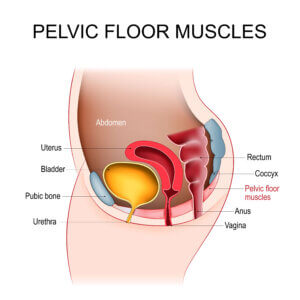
You may have heard of Kegels as the “standard” pelvic floor exercise. They can be very helpful for strengthening weak pelvic muscles, but think of them as just one possible exercise option.
Also, Kegels may not be the best choice for a tight pelvic floor and can even make things worse.
Here’s what you do:
- Start by lying on the floor with your knees bent (easiest), sitting up straight, or standing.
- Find your pelvic floor muscles by imagining you are trying to hold in urine.
- Squeeze these muscles together (without tightening your butt, thigh, etc. muscles) and hold for 5-8 seconds.
- Relax these muscles fully for 5-8 seconds.
- Repeat the above steps 8-10 times.
Standing Pelvic Tilt
This exercise helps to strengthen both your pelvic floor and lower back muscles. Again, it will be more beneficial for a weak pelvic floor than a tight one.
Here’s how you do it:
- Stand up straight with your back and heels against a wall.
- Push your lower back against the wall, feeling your pelvic floor muscles activate.
- Hold that position for 5-10 seconds, then relax for the same amount of time.
- Repeat 8-10 times, gradually building up to longer holds.
Heel Slides
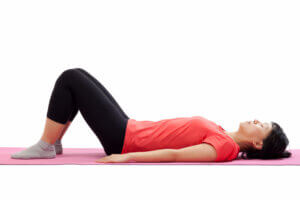
Heel slides are beneficial for promoting pelvic floor contractions and work some of the deeper core muscles that you may not use regularly. Here’s how you practice them:
- Lay on the floor with your knees bent and feet on the floor. Relax your pelvis to a “neutral” position.
- Find your pelvic floor muscles (see tips in the ‘Kegels’ section), squeeze them together, and lock in the rest of your core.
- Keep all these muscles activated and slowly slide one heel away from you. Only go as far as you can without losing your core activation.
- Once you’ve reached your maximum point, bring your heel back to its starting position and relax.
- Repeat up to 10 times, then switch to the other heel.
Bridge Pose
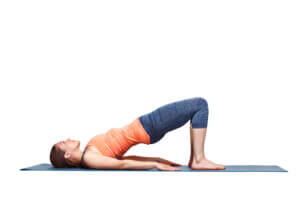
Bridge pose is great for strengthening your core and back muscles. By specifically focusing on your pelvic floor as you do it, it becomes even more helpful.
Here are the basic steps:
- Lie flat on your back with your knees bent upwards and your arms straight at your side.
- Press your feet into the floor and push your hips up into the air. Make sure you activate your pelvic floor muscles as you do so.
- Hold this position for several breaths, then relax.
- Repeat a few times, building up gradually.
Happy Baby Pose

Happy Baby is a yoga pose that helps to stretch and relax muscles in the pelvic area. It can be a great way to release tight pelvic floor muscles (and might make you more relaxed overall, too!).
Here’s how to do this pose:
- Lie on your back with your knees bent upwards.
- Slowly bring your knees towards your stomach until the soles of your feet point up.
- Grab the inside or outside of your feet (whichever feels better).
- Gently pull your feet apart as much as feels comfortable, keeping your ankles over your knees.
- Hold this position for several breaths and focus on relaxing your pelvic floor muscles.
Child’s Pose

Child’s pose can help release tension in your entire spine, all the way down to your tailbone— which is right behind your pelvic floor. It’s easy to do by following these steps:
- Start on your hands and knees with your hands lined up under your shoulders and your knees under your hips.
- Move your big toes together and slide your knees out to be wider than hip-width apart.
- Slowly sit back on your heels. Then, slide your hands forward on the floor until your forehead touches the ground. (Use a pillow if your forehead doesn’t make it that far.)
- Hold this pose for several breaths, relaxing your spine and pelvic floor.
Reclined Butterfly Stretch

This stretch helps with tightness in your hips and inner thighs. Doing it reclined instead of seated really allows for your pelvic floor muscles to stretch and relax.
Here’s how to do it:
- Lie on your back with your knees bent upward.
- Move your feet together, turn them so the soles are touching, and allow your knees to fall outwards toward the floor. Make sure your lower back is flat and not arching.
- Hold this position for several breaths.
Tip: To relax your pelvic floor/inner thighs even more, place pillows under your knees while in the butterfly position.
Diaphragmatic Breathing
This is one of the best exercises you can do for a tight pelvic floor, although it’s also great for any type of tension. It encourages you to breathe deeply using your diaphragm, which is the “roof” of your core and connected to your pelvic floor.
You can do this exercise seated, but it’s most relaxing when you lie down:
- Lie on your back (or sit) in a comfortable position.
- Place one hand on your stomach and one on your chest.
- Breathe in deeply and focus on expanding your belly while keeping your chest still.
- Exhale slowly, relaxing the muscles in your body.
- Repeat as many times as needed.
Other Natural Ways to Support Your Pelvic Floor
Improve Blood Flow
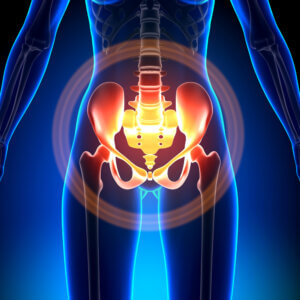
All muscles in your body need oxygen- and nutrient-rich blood to function properly.
Unfortunately, many parts of modern life (including poor posture and a less-than-ideal diet) can restrict blood flow to your pelvic floor. This happens in part because the fascia (connective tissues) surrounding pelvic floor muscles becomes tight and restrictive.
The good news is that many of the above exercises and stretches for your pelvic floor will help with blood flow, too.
Another even more effective option to consider is using a small massage ball on your perineal area. Massage, in general, has been shown to stimulate blood flow, and the ball helps to release both fascia and tight pelvic floor muscles.
(See the end of this post for how to choose the right massage ball!)
Sit Less & Practice Good Posture
Sitting too much contributes to a boatload of health problems (more on that another time) and can also put pressure on your pelvic floor (and tailbone), especially if you have poor posture. Hunching or leaning forward is especially problematic because it tilts your pelvis forward and puts downward force on pelvic floor muscles.
The best way to sit is fully against the back of a chair with the back rest supporting your spine. Your lower spine should have a slight inward curve, but everything else should be aligned— head and shoulders over tailbone.
In addition to working on posture, be intentional about taking regular break to move and relax pressure on your pelvic floor.
If you have weak pelvic floor muscles, try lower impact exercises like walking to break up time spent sitting. And avoid walking in high heels as much as possible!
Diet & Herbs

There’s no such thing as a bulletproof “pelvic floor diet,” but there are some foods/drinks that support your pelvic floor— and some that should be avoided.
On the list of good foods to eat are:
- Pure water— Helps with all bodily functions by hydrating and flushing out waste products. (Just make sure your water is free from toxins.)
- Fruits/veggies low in acid— Includes bananas, melons, beans, carrots, etc.
- Omega 3s— Naturally decrease inflammation. (Find the top plant-based omega 3s here.)
- Herbal teas— Good for hydration and caffeine-free.
Some foods you may want to limit include:
- Caffeine— Acts as a diuretic to increase urine output, which could contribute to an overactive bladder.
- Carbonated beverages— Can trigger an overactive or irritated bladder.
- Fruits/veggies high in acid & spicy foods— Overdoing acidity or heat can irritate your bladder lining.
- Artificial sweeteners— May worsen an overactive bladder.
- Alcohol— A diuretic.
Additionally, there aren’t any herbs/spices confirmed to help with pelvic floor issues, but those that fight pain and inflammation (ginger, cayenne, turmeric) or calm muscle spasms (valerian, peppermint) may be beneficial.
Heat, Baths, & Magnesium
There are some natural techniques that won’t necessarily support your pelvic floor in the long run but can effectively provide short-term relaxation and relief.
For example, heat from hot packs, heating pads, or hot water bottles applied to your pelvic area can be very soothing. Warm to hot baths also help relax all your muscles, particularly with the addition of Epsom salts.
Be mindful of magnesium, which is an essential mineral that’s critical for proper muscle function. A deficiency can lead to muscle spasms and, unfortunately, many people fall short on this nutrient. You may want to consider getting more of it in your diet through foods like beans, seeds, spinach, and cocoa powder or supplementing.
Top Recommendation: Cooch Ball for Pelvic Floor Relief
If you want a quick and effective way to support and release your pelvic floor, look into the easy-to-use Cooch Ball.
This small massage ball is specifically designed (by a woman) to improve blood flow to the pelvic floor and help release tight pelvic floor muscles. It can be filled up to perfectly fit the anatomy of any woman and is lightweight and transportable.
Best of all, using a Cooch Ball takes only 3 minutes a day— and all you have to do is sit on it to release fascia, increase blood flow, and support your pelvic floor.
You can find out more about the Cooch Ball and its outstanding real-life results here. And strongly consider adding some of the simple, natural techniques above to your daily routine to strengthen and support your pelvic floor for years to come!


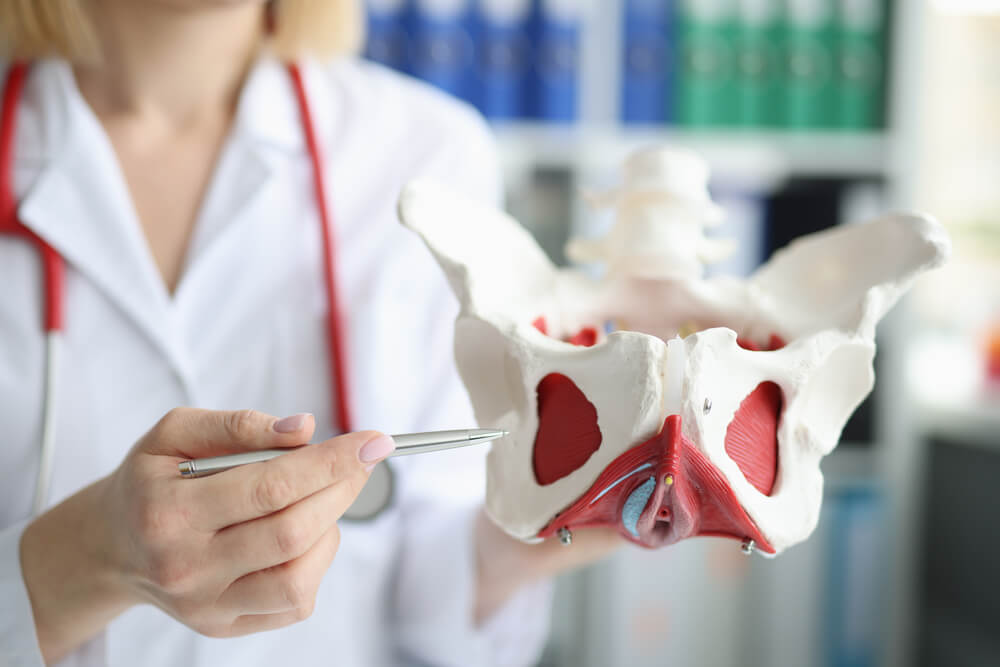

Thanks! Really helpful article to address a common issue. Glad to know that there are ways to improve or maintain the muscles of the pelvic floor.
You forgot the one most effective exercise, rebounding on a mini trampoline, which tones every muscle in the entire body. It’s how I resolved vaginal prolapse from having my 2nd child after kegels and all that other stuff including physical therapy didn’t work for me.
How can I download this really important article?
Extensive and helpful material.
Thank you.
Thank you! That sounds very good and I’m going to apply your advice.
Thank you, very inspirational and helpful. Easy to use exercises.
Thank you! Much appreciate the informative article
thanks. a very well written and helpful article..
fantastic! thank you so much.
Very timely for one who has recently had major hip surgery. Until the time leading up to the surgery, when I was having much trouble in walking, let alone doing any real exercise, and then for weeks afterwards when movement was rather limited, I had not had any pelvis or urination problems. Afterwards I found that I had to urinate much more often , including in the middle of the night or other inconvenient times, and it was harder to control the liquid. This article is most helpful and comes at a time when I am undergoing physiotherapy to strengthen my hip, leg, back, waist and even shoulder muscles. I shall share it with my physiotherapist. I don’t think that most people realize that hip surgery can impinge on urinary tract muscles, and that those need re-strengthening at the same time as the hip and leg muscles. And mainly the health professionals don’t tell one about the weakness that occurs in the urinary tract areas as a result of the surgery. The exercises in this article reinforce the physio exercises I’ve been doing.
Perhaps in your next article you can mention the linkage between hip (& even knee)
surgeries and weak urinary (& even rectal) muscles, and show how they can be strengthened as you have shown here.
Thanks for showing us that we can overcome the weakness with exercise and patience.
Great information. Essential and well delivered. Sharing with all.
This article was pretty inclusive of exercises to help strengthen the pelvic floor, but I was surprised that biofeedback to train the body to perform more effective Kegels exercises was not mentioned. This is done by physical therapists specifically trained in this field. Obviously it is another natural method to strengthen the pelvic floor.
THIS IS AN EXCELLENT ARTICLE, VERY WELL DONE, VERY CLEAR AND COGENT, INSPIRATIONAL AND SIMPLE TO INITIATE, MAKING A ROUTINE PRACTICE OF THE MOVEMENTS VERY EASY TO SUPPORT. THANK YOU FOR SUCH A VALUABLE TOOL, GIVING THE BASIC INFORMATION NEEDED TO ASSIST WITH HEALTHY FUNCTION.
Good to hear that the Pilates exercises we do regularly are they ones you include in this blog post
Great article, thank you!